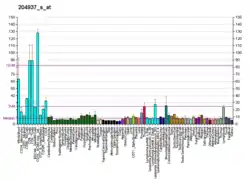ZNF274
Zinc finger protein 274 is a protein that in humans is encoded by the ZNF274 gene.[5][6]
This gene encodes a zinc finger protein containing five C2H2-type zinc finger domains, one or two Kruppel-associated box A (KRAB A) domains, and a leucine-rich domain. The encoded protein has been suggested to be a transcriptional repressor. It localizes predominantly to the nucleolus. Alternatively spliced transcript variants encoding different isoforms exist. These variants utilize alternative polyadenylation signals.[6]
References
- GRCh38: Ensembl release 89: ENSG00000171606 - Ensembl, May 2017
- GRCm38: Ensembl release 89: ENSMUSG00000021514 - Ensembl, May 2017
- "Human PubMed Reference:". National Center for Biotechnology Information, U.S. National Library of Medicine.
- "Mouse PubMed Reference:". National Center for Biotechnology Information, U.S. National Library of Medicine.
- Yano K, Ueki N, Oda T, Seki N, Masuho Y, Muramatsu M (Jun 2000). "Identification and characterization of human ZNF274 cDNA, which encodes a novel kruppel-type zinc-finger protein having nucleolar targeting ability". Genomics. 65 (1): 75–80. doi:10.1006/geno.2000.6140. PMID 10777669.
- "Entrez Gene: ZNF274 zinc finger protein 274".
Further reading
- Maruyama K, Sugano S (1994). "Oligo-capping: a simple method to replace the cap structure of eukaryotic mRNAs with oligoribonucleotides". Gene. 138 (1–2): 171–4. doi:10.1016/0378-1119(94)90802-8. PMID 8125298.
- Suzuki Y, Yoshitomo-Nakagawa K, Maruyama K, et al. (1997). "Construction and characterization of a full length-enriched and a 5'-end-enriched cDNA library". Gene. 200 (1–2): 149–56. doi:10.1016/S0378-1119(97)00411-3. PMID 9373149.
- Petroni D, Bartolini E, Chiaramonte R, et al. (1999). "Computer sequence analysis of human highly conserved zinc finger modules". DNA Seq. 9 (3): 163–9. doi:10.3109/10425179809072191. PMID 10520746.
- Casademunt E, Carter BD, Benzel I, et al. (2000). "The zinc finger protein NRIF interacts with the neurotrophin receptor p75(NTR) and participates in programmed cell death". EMBO J. 18 (21): 6050–61. doi:10.1093/emboj/18.21.6050. PMC 1171670. PMID 10545116.
- Strausberg RL, Feingold EA, Grouse LH, et al. (2003). "Generation and initial analysis of more than 15,000 full-length human and mouse cDNA sequences". Proc. Natl. Acad. Sci. U.S.A. 99 (26): 16899–903. Bibcode:2002PNAS...9916899M. doi:10.1073/pnas.242603899. PMC 139241. PMID 12477932.
- Ota T, Suzuki Y, Nishikawa T, et al. (2004). "Complete sequencing and characterization of 21,243 full-length human cDNAs". Nat. Genet. 36 (1): 40–5. doi:10.1038/ng1285. PMID 14702039.
- Gerhard DS, Wagner L, Feingold EA, et al. (2004). "The Status, Quality, and Expansion of the NIH Full-Length cDNA Project: The Mammalian Gene Collection (MGC)". Genome Res. 14 (10B): 2121–7. doi:10.1101/gr.2596504. PMC 528928. PMID 15489334.
- Wan D, Gong Y, Qin W, et al. (2004). "Large-scale cDNA transfection screening for genes related to cancer development and progression". Proc. Natl. Acad. Sci. U.S.A. 101 (44): 15724–9. Bibcode:2004PNAS..10115724W. doi:10.1073/pnas.0404089101. PMC 524842. PMID 15498874.
- Sripathy SP, Stevens J, Schultz DC (2007). "The KAP1 Corepressor Functions To Coordinate the Assembly of De Novo HP1-Demarcated Microenvironments of Heterochromatin Required for KRAB Zinc Finger Protein-Mediated Transcriptional Repression". Mol. Cell. Biol. 26 (22): 8623–38. doi:10.1128/MCB.00487-06. PMC 1636786. PMID 16954381.
External links
- ZNF274+protein,+human at the US National Library of Medicine Medical Subject Headings (MeSH)
- FactorBook ZNF274
This article incorporates text from the United States National Library of Medicine, which is in the public domain.
This article is issued from Wikipedia. The text is licensed under Creative Commons - Attribution - Sharealike. Additional terms may apply for the media files.




